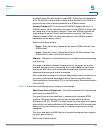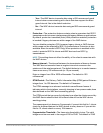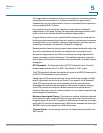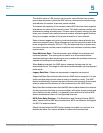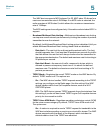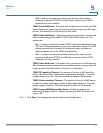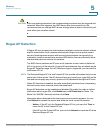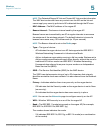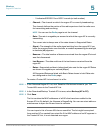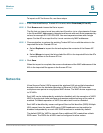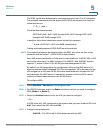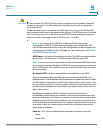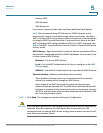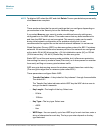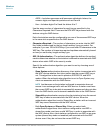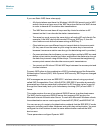
Wireless
Rogue AP Detection
Cisco Small Business WAP551 and WAP561 Wireless-N Access Point 68
5
- 5 indicates IEEE 802.11a or 802.11n mode (or both modes).
• Channel—The channel on which the rogue AP is currently broadcasting.
The channel defines the portion of the radio spectrum that the radio uses
for transmitting and receiving.
NOTE You can use the Radio page to set the channel.
• Rate—The rate in megabits per second at which the rogue AP is currently
transmitting.
The current rate is always one of the rates shown in Supported Rates.
• Signal—The strength of the radio signal emitting from the rogue AP. If you
hover the mouse pointer over the bars, a number representing the strength
in decibels (dB) appears.
• Beacons—The total number of beacons received from the rogue AP since it
was first discovered.
• Last Beacon—The date and time of the last beacon received from the
rogue AP.
• Rates—Supported and basic (advertised) rate sets for the rogue AP. Rates
are shown in megabits per second (Mbps).
All Supported Rates are listed, with Basic Rates shown in bold. Rate sets
are configured on the Radio page.
To create a Trusted AP List and save it to a file:
STEP 1 In the Detected Rogue AP List, click Trust for APs that are known to you. The
Trusted APs move to the Trusted AP List.
STEP 2 In the Download/Backup Trusted AP List area, select Backup (AP to PC).
STEP 3 Click Save.
The list contains the MAC addresses of all APs that have been added to the
Known AP List. By default, the filename is Rogue2.cfg. You can use a text editor or
web browser to open the file and view its contents.
You can import a list of known APs from a saved list. The list might be acquired
from another AP or created from a text file. If the MAC address of an AP appears in
the Trusted AP List, it is not detected as a rogue.



